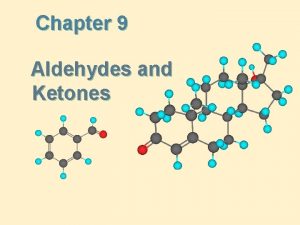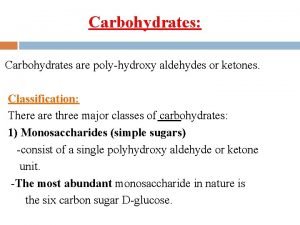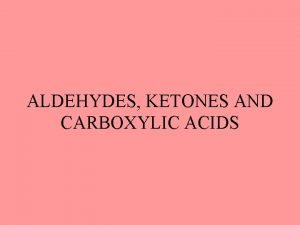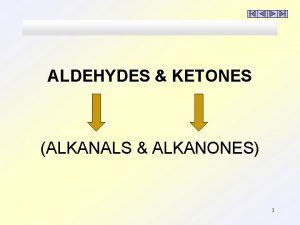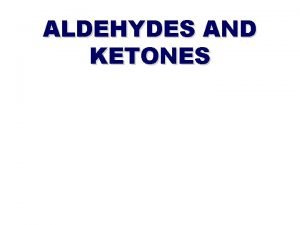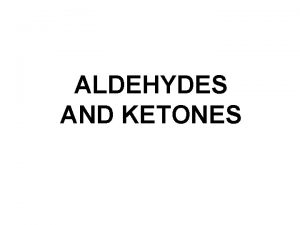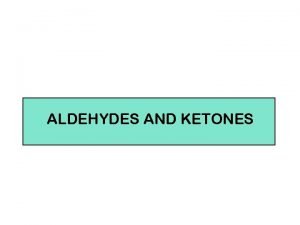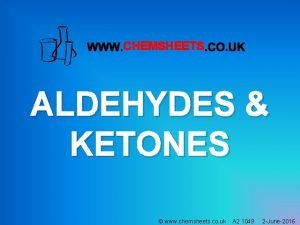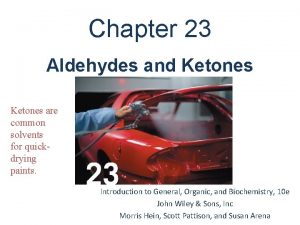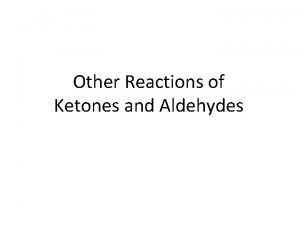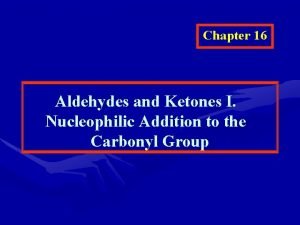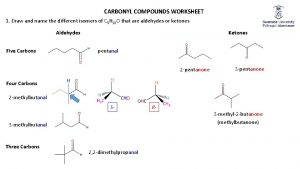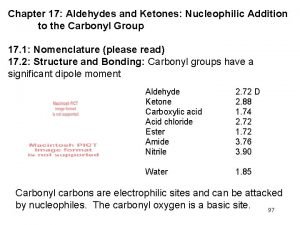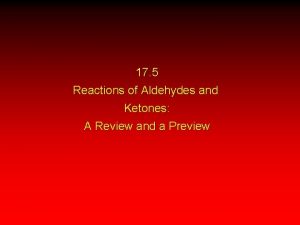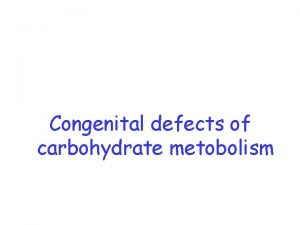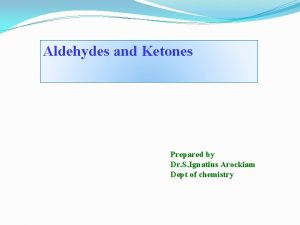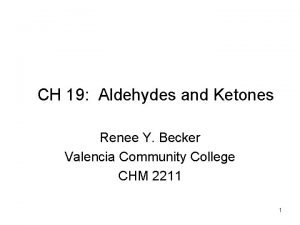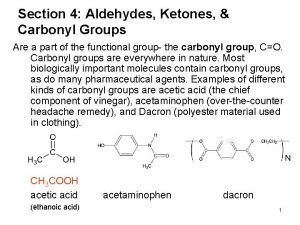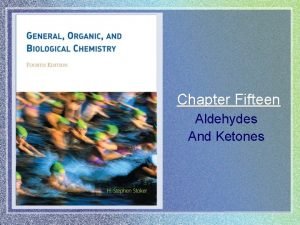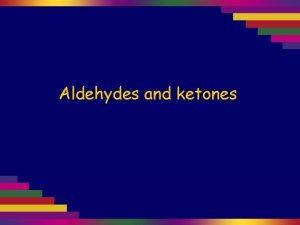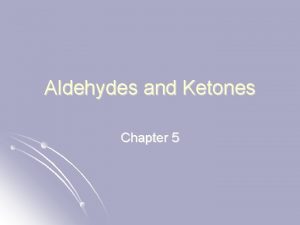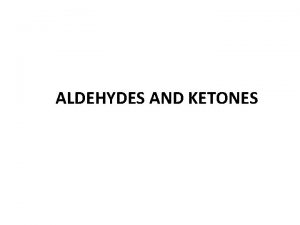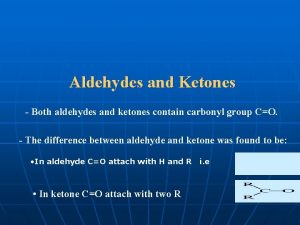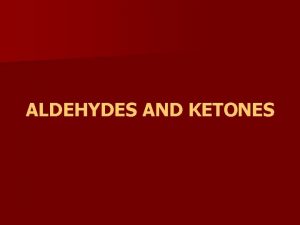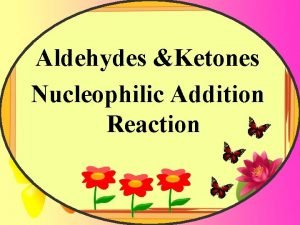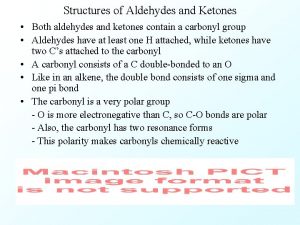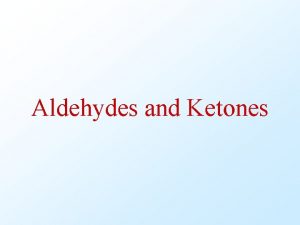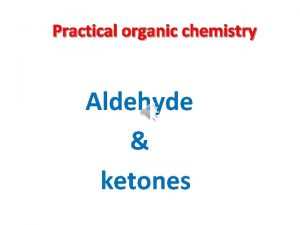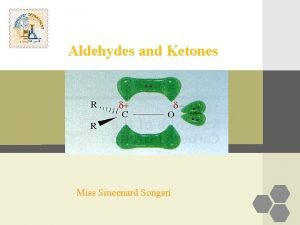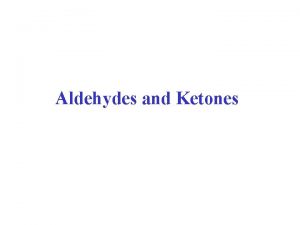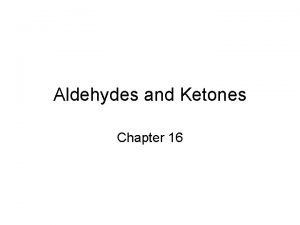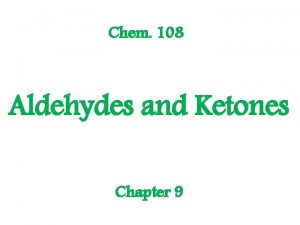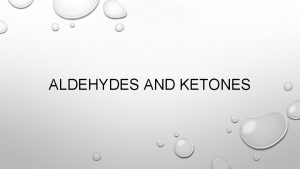Aldehydes and ketones 1435 1436 2014 2015 1





















- Slides: 21

Aldehydes and ketones 1435 -1436 2014 -2015 1

Aldehydes and ketones Learning Objectives Chapter eight introduces carbonyl compounds and reactions that involve a nucleophilic attack at the carbonyl carbon in addition to the other topics. By the end of this chapter the student will: ØKnow the structural differences between aldehydes and ketones ØKnow how to draw aldehydes and ketones Ø know the common and IUPAC nomenclature of aldehydes and ketones Ø Know the physical properties of aldehydes and ketones ØKnow how to synthesize an aldehyde or a ketone from a compound without that functionality. Ø Know the different nucleophilic attack reactions at the carbonyl carbon and the specific products formed in each case. 2

Aldehydes and ketones ALDEHYDES: STRUCTURE AND NOMENCLATURE Ø General formula: RCHO or Ø Bond line formula Ø The polarity of C=O Ø The aldehyde group is always (terminal)at the end of a chain Common Nomenclature Of Aldehydes Ø Common name of aldehydes are derived from the common name of the corresponding acid Ø Some aliphatic aldehydes have common names which have to be memorized. Formaldehyde 145 Chem. Acetaldehyde Propionaldehyde Butyraldehyde 3

Aldehydes and ketones Ø Some aromatic aldehydes have common names such as: Salicylaldehyde (o-Hydroxybenzaldehyde) 4 Anisaldehyde (p-methoxybezaldehyde) IUPAC Nomenclature ØSelect the longest continuous carbon chain that contains the H-C=O group to get the name of the parent hydrocarbon, then replace the ending e by the suffix –al ØThe CHO group is assigned the local 1 and takes precedence over other functional groups that may present such as C=O(ketone), –OH, C=C, CΞC, OR ØFor cyclic aldehydes in which the –CHO group is attached to the ring, the suffix carbaldehyde is used. 4

Aldehydes and ketones Methanal Ethanal Propanal Butanal Cis-2 -Hydroxy cyclopentane 3 -Chlorobutanal 3 -Hydroxypropanal 2 -Butenal carbaldehyde ØAromatic aldehydes are usually designated as derivatives of the simplest aromatic aldehyde, Benzaldehyde 4 -Nitrobenzaldehyde 2 -Hydroxybenzaldehyde 4 -Methoxybenzaldehyde 5

Aldehydes and ketones KETONES: STRUCTUR AND NOMENCLATURE Ø General formula: RCOR’ (R and R’=alkyl or aryl) Ø Common names of ketones derived by listing the alkyl substituents attached to the carbonyl group in alphabetical order, followed by the word ketone. Ø In common names carbon atoms near the carbonyl group are often designated using Greek letters (α, ᵝ, ɣ , δ…. . ) beginning with carbon next the carbonyl group. Ø When a complex molecules contains more than one of functional groups, an order of precedence is used to determine the name. Ø The functional group priority order in nomenclature system is as following: Acid and derivatives > aldehyde > ketone > alcohol > amine > alkene > alkyne > ether 6 6

Aldehydes and ketones Acetone Dimethyl ketone Acetophenone Methyl phenyl ketone 3 -Buten-2 -one Methyl vinyl ketone Benzophenone Diphenyl ketone IUPAC Nomencalture : ØSelect the longest continuous carbon chain that contains the C=O group to get the name of the parent hydrocarbon, then replace the ending e by the suffix –one ØThe chain is numbered in such a way as give the lowest number to the C=O group. ØThe prefix of oxo is used if there are higher ranking functional groups present. 7 7

Aldehydes and ketones Propanone Phenyl ethanone Cyclopentylpropanone 3 -Buten-2 -one 3 -Ethyl-2 -hydroxycyclohexanone Diphenylmethanone 5 -Oxohexanal 8

Aldehydes and ketones Physical Properties OF Aldehydes And Ketones Ø The carbonyl group is polar; with a partial negative charge on oxygen atom, and partial positive charge on carbon atom. Ø Because the polarity of the carbonyl group, aldehydes and ketones are polar compounds. 1) Boiling and melting points Ø Higher melting and boiling points compared to analogous alkanes due to they show dipole-dipole attractions. Ø These attractions although important, are not as strong as interactions due to hydrogen bonding as a result, the boiling points of aldehydes and ketones are higher than those of non polar alkanes, but lower than those of alcohols whose molecules are connected together by H-bonds. 9

Aldehydes and ketones 2) Solubility ØLower aldehydes and ketones are more soluble than alkanes but less soluble than alcohols in aqueous media 10

Aldehydes and ketones Preparation Of Aldehydes And ketones: 1 - Oxidation of Alcohols 11

Aldehydes and ketones 2 - Ozonolysis of Alkenes: results in formation of aldehydes or ketones depending on structure of the alkene used. 12

Aldehydes and ketones 3 - Hydration Of Alkynes 4 - Friedel Crafts Acylation N. B: -COR group is m-director and deactivating towards electrophiles 13

Aldehydes and ketones Reactions Of Aldehydes And Ketones the most common reactions are : Nucleophilic addition reactions 1 - Reduction : Formation Of Alcohols The reduction by Na. BH 4 , Li. Al. H 4 ; the hydride ion H- is serve as nucleophile. 14

Aldehydes and ketones 2 -Nucleophilic addition of Grignard reagent (formation of alcohols) Ø Addition of RMg. X to formaldehyde gives 1◦ alc. Ø Addition of RMg. X to any other aldehyde gives 2◦ alc. Ø Addition of RMg. X to ketones gives 3◦ alc. 3 - Oxidation reaction Only aldehydes can be oxidized ketones resist oxidation 15

Aldehydes and ketones 5 -Addition of Hydrogen Cyanide: Formation Of Cynohydrins 16

Aldehydes and ketones 6 - Addition Of Alcohols: 17

Aldehydes and ketones 7 - Addition of Ammonia and Ammonia Derivatives 145 Chem. 18 18

Aldehydes and ketones Exercis es 1 - The correct name of the following compound is: A) 3 -hydroxyhexanal B) 3 -hydroxy-4 -hexenal C) 4 -hydroxy-5 -hexenal D)3 -hydroxy-1 -hexenal 2 - The structure of Acetal is: 145 Chem. 19 19

Aldehydes and ketones 3 - Reaction of phenyhydrazine with carbonyl compounds (aldyhydes or ketones) gives: A) Oxime B) Phenylhydrazone C) Imine D) Hemiacetal 4 - Which of the following compounds has the highest boiling point? 145 Chem. 20 20

Aldehydes and ketones Thank You for your kind attention ! Questions? Comments 21
 Aldehydes and ketones structure
Aldehydes and ketones structure Carbohydrates are polyhydroxy aldehydes and ketones
Carbohydrates are polyhydroxy aldehydes and ketones Aldehydes and ketones
Aldehydes and ketones Alkanone ketone
Alkanone ketone Ch3ch2ch2cch2ch3
Ch3ch2ch2cch2ch3 Carbonyl group aldehyde and ketone
Carbonyl group aldehyde and ketone Carbonyl vs ketone
Carbonyl vs ketone Butanone and acidified kcn
Butanone and acidified kcn Chemical properties of aldehydes
Chemical properties of aldehydes Relative reactivity of aldehydes and ketones
Relative reactivity of aldehydes and ketones Aldehyde protecting group
Aldehyde protecting group Naming aldehydes and ketones worksheet with answers doc
Naming aldehydes and ketones worksheet with answers doc Aldehydes and ketones nucleophilic addition
Aldehydes and ketones nucleophilic addition Cyanohydrin formation
Cyanohydrin formation Az1435
Az1435 Rd 1435/1992
Rd 1435/1992 Galactosemia mechanism
Galactosemia mechanism Aldehyde and ketones
Aldehyde and ketones What are the functional group
What are the functional group Ch3li reaction with ketone
Ch3li reaction with ketone Naming ether
Naming ether Carbonyl group
Carbonyl group
